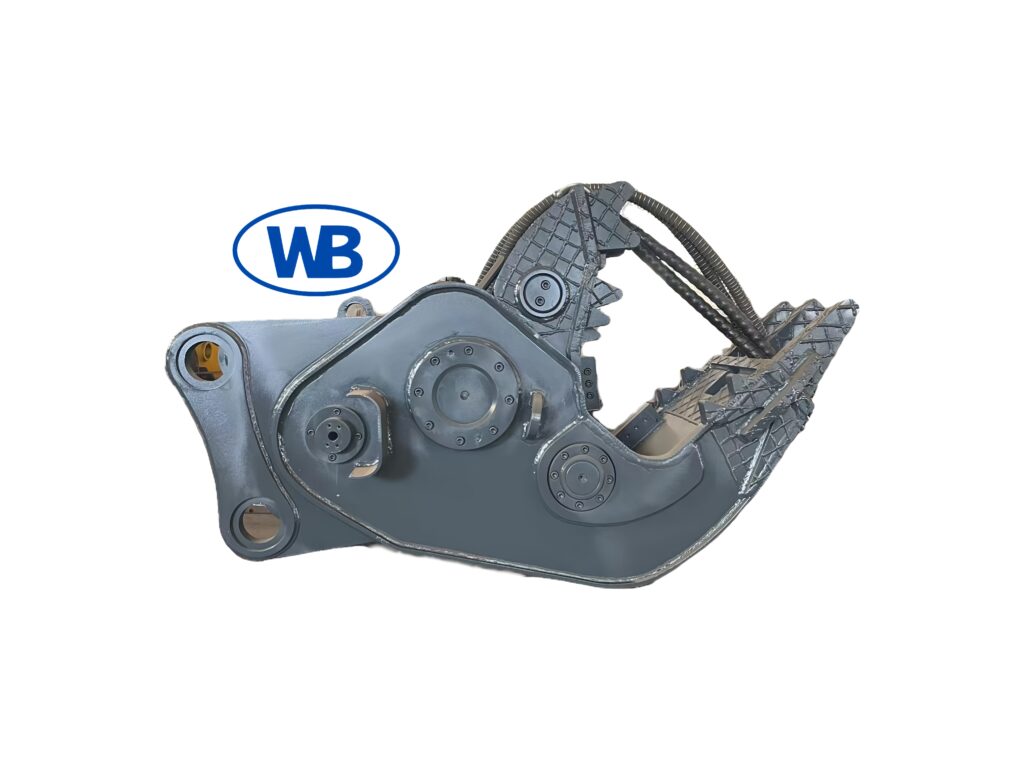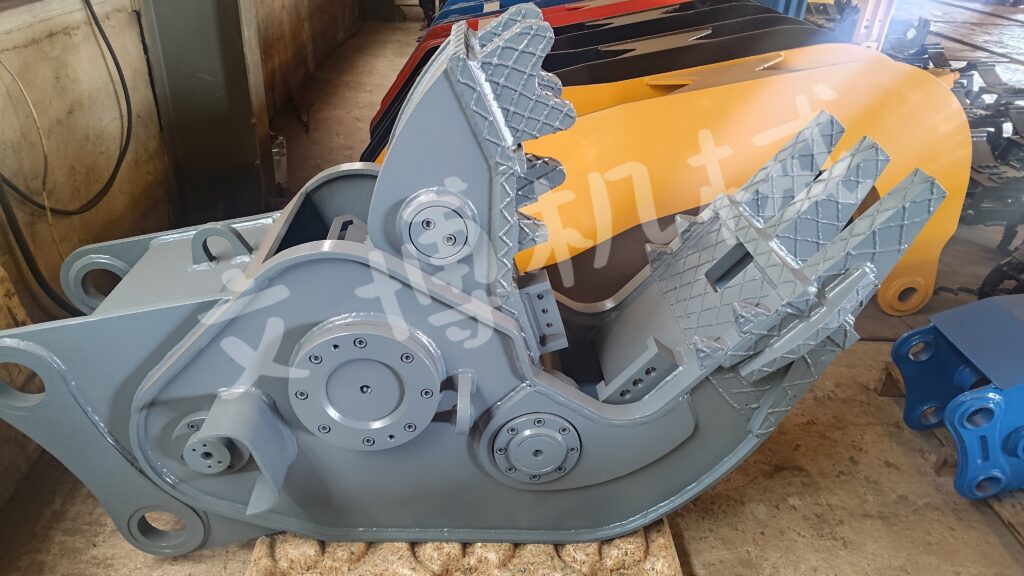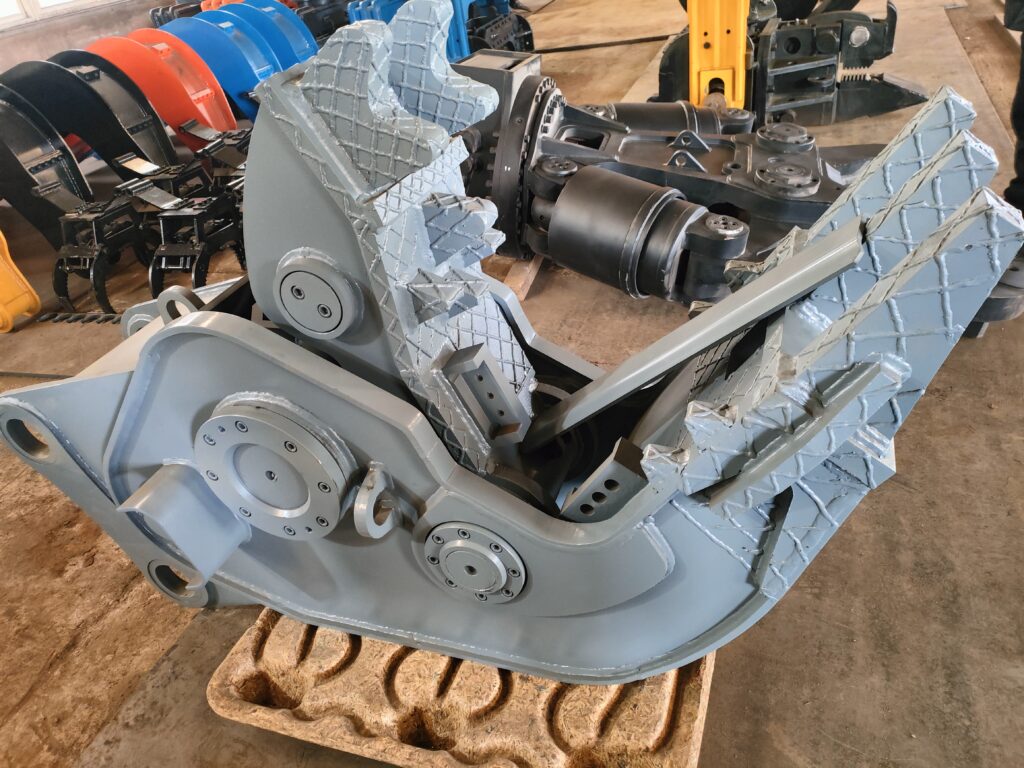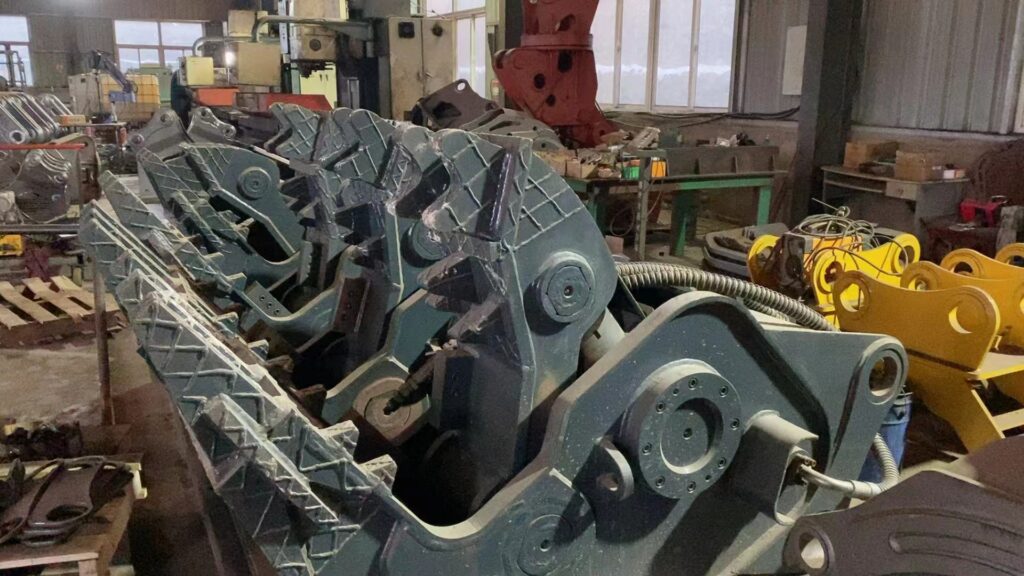A concrete crusher is a heavy-duty machine designed to break up large blocks of concrete into smaller, more manageable pieces. It is commonly used in the demolition and recycling industries to break up and pulverize concrete structures or concrete fragments from demolished buildings or bridges.
The main purpose of a concrete crusher is to reduce the size of concrete debris to make it easier to handle, transport, and recycle. A crusher typically consists of a sturdy frame, crushing jaws or plates, and a hydraulic or mechanical mechanism that applies force and pressure to the concrete.

1. How to use a hydraulic crusher?

To use a concrete crusher safely and effectively, follow these general steps:
Equipment Inspection:
Before using a concrete crusher, thoroughly inspect it to ensure that all parts are in good working order. Pay attention to the condition of the crushing jaws or plates, hydraulic or mechanical components, and any safety devices.
Equipment Preparation:
Attach the concrete crusher to the designated heavy machinery (e.g., excavator) using compatible quick-connects. Make sure the attachment is securely connected and properly locked in place.
Safety Precautions:
Wear appropriate personal protective equipment (PPE), including a hard hat, goggles, gloves, and steel-toed boots. Make sure the work area is clear of people and hazards that could interfere with the operation.
Positioning:
Place the heavy machinery and concrete crusher in the best position for easy access. Make sure there is enough space for the crusher to operate without obstruction.
Engage the hydraulic controls:
If the concrete crusher is hydraulically operated, make sure the hydraulic system is properly activated and pressurized. Be familiar with the controls and levers that operate the crusher attachment.
Approach the concrete structure: Aim the excavator at the concrete structure or debris to be crushed. Slowly approach the target, allowing the crusher’s crushing jaws or plates to contact the concrete surface.
Apply pressure:
Activate the hydraulic controls or mechanical devices to apply pressure to the concrete. Gradually increase the force to break the concrete into small pieces. Pay attention to the progress of the crushing and avoid unnecessary excessive force that may damage the equipment or cause an unsafe situation.
Move and maneuver:
Move the heavy machinery or maneuver the excavator’s arm or boom as needed to access different areas of the concrete structure. Be careful to evenly distribute the crushing force and cover the entire target area.
Sorting and separating:
After the concrete is crushed, use the crusher’s jaws or plates to separate the steel or metal reinforcement from the crushed concrete. This sorting process facilitates recycling and reduces waste.
Repeat and Adjust:
Repeat the crushing and sorting process as needed until the desired results are achieved. Adjust the position of the crusher and the pressure application according to the specific characteristics of the concrete structure.
Post-Operation Inspection:
After completing the crushing process, inspect the crusher and heavy machinery for any damage or excessive wear. Clean the equipment properly and remove any residual debris.
Always follow the manufacturer’s guidelines and instructions for specific operation, maintenance and safety procedures for concrete crushers. If you are new to concrete crushers, consider receiving proper training or guidance from an experienced operator or equipment provider to ensure safe and effective use.
2. How Do Hydraulic Crusher Work?
Hydraulic crushers utilize hydraulic power to operate their crushing mechanism. Here is an overview of how hydraulic crushers work:
Hydraulic System
Hydraulic crushers are connected to a hydraulic system, which is usually driven by an excavator or other heavy machinery. The hydraulic system provides the force and pressure required for the crusher to operate.


Crushing Jaw Crusher or Crushing Plate:
Hydraulic crushers are equipped with powerful serrated crushing jaws or hydraulic control plates. These jaws or plates apply pressure to the concrete, breaking it up into small pieces.
Hydraulic Cylinders:
Hydraulic cylinders are driven by the hydraulic system and are responsible for applying pressure to the crushing jaws or plates. Once activated, the cylinders extend and retract, creating the crushing force needed to pulverize the concrete.
Hydraulic Valves and Controls:
The hydraulic system includes valves and controls that regulate the flow and pressure of hydraulic oil in the cylinders. These controls are usually operated by the excavator operator, allowing for precise control of the crushing process.
Crushing Process:
To use a hydraulic crusher, the operator positions the crusher jaws or plates over the concrete structure or debris to be crushed. Once in place, the operator activates the hydraulic controls to apply pressure to close the crushing jaws or plates on the concrete.
Crushing Force:
As the hydraulic cylinders extend, the crushing jaws or plates apply strong force to the concrete. The serrated edges of the jaws or plates grab the concrete and break it into small pieces.
Size Adjustment:
Some hydraulic crushers allow for adjustment of the jaw crusher or plate opening, enabling the operator to control the size of the crushed material. This feature enables the crusher to produce different sizes of material depending on the specific requirements of the project or recycling process.
Rebar and Metal Separation:
During the crushing process, the hydraulic crusher can also help separate any rebar or metal reinforcement embedded in the concrete. The jaws or plates of the crusher can clamp and manipulate the rebar, thereby sorting and separating it from the crushed concrete.
Crushing Process and Operation:
The operator closely monitors the crushing process, adjusting the hydraulic controls as needed to achieve the desired results. The crushing operation continues until the concrete is effectively crushed to the desired size and any rebar or metal is separated.
The precise operation and function of the hydraulic crusher may vary depending on the specific manufacturer and model. It is critical to consult the manufacturer’s guidelines and instructions for the proper operation, maintenance and safety procedures of the specific hydraulic crusher.
3. How to choose an excavator concrete crusher?

“Choosing a concrete crusher for your excavator requires consideration of several factors to ensure the best match for your specific needs. Here are some key considerations to help guide your selection process:
Excavator Compatibility:
The first factor to consider is whether the concrete crusher is compatible with your excavator. Check the manufacturer’s specifications to ensure the crusher is designed to fit the size, weight, and hydraulic capabilities of your excavator.
Crusher Size and Weight:
Evaluate the size and weight of the concrete crusher. It should be appropriate for the demolition and recycling tasks you intend to perform. Consider the space constraints at your job site and any transportation requirements when selecting the size and weight of the crusher.
Crushing Force:
Evaluate the crushing force of the crusher. The crushing force should be sufficient to effectively break the concrete structure or debris you are dealing with. Consider the compressive strength and thickness of the concrete to ensure the crusher can handle the workload required.
Jaw or Plate Configuration:
Determine the type of crushing mechanism you need. Concrete crushers are typically equipped with either a crushing jaw or a crushing plate. Jaws are good for crushing concrete structures, while crushing plates are good for crushing concrete slabs and walls. Consider your specific demolition requirements and select the appropriate configuration.
Adjustable Jaw or Plate Opening:
Determine if you need the ability to adjust the jaw crusher or crushing plate opening. Adjustable openings allow you to control the size of the crushed material, which is useful for recycling purposes or to meet specific project requirements.
Durability and Construction:
Make sure the concrete crusher is built with quality materials and durable components. It should be able to withstand the rigors of heavy-duty demolition work. Look for features such as reinforced construction, wear-resistant components, and a rugged hydraulic system.
Safety Features:
Check for necessary safety features such as proper guards, hydraulic overload protection, and safety locks. These features help minimize the risk of accidents and protect the operator and those around them.
Manufacturer Reputation and Support:
Consider the manufacturer’s reputation and track record. Look for a reputable company known for producing reliable, high-performance concrete crushers. Also, evaluate the availability of spare parts, maintenance support, and after-sales service to ensure long-term support for your investment.
Budget:
Evaluate the cost of a concrete crusher based on your budget. While it is important to find an excavator concrete crusher that meets your requirements, it is also essential to consider the overall value and return on investment it provides.
User Reviews and Recommendations:
Finally, seek user reviews and recommendations from other professionals in the industry who have first-hand experience with different models of concrete crushers. Their insights can provide valuable information to help you make an informed decision.
By considering these factors, you can choose an excavator concrete crusher that meets your specific requirements, provides the best performance, and has long-term durability and value. ”
WB hydraulic crushers consist of a main body, hydraulic cylinder, movable jaw, and fixed jaw. For more information about WB concrete crushers, please feel free to contact us.
How do hydraulic crushers improve work efficiency?
The hydraulic crusher is driven by a hydraulic cylinder and achieves the purpose of crushing objects by controlling the angle between the movable jaw and the fixed jaw. The WB hydraulic crusher uses a speed-increasing valve to allow the oil in the rod chamber of the cylinder to return to the rodless chamber through hydraulic pressure, accelerate when the hydraulic cylinder is extended, and reduce the idle stroke time. While keeping the cylinder thrust unchanged, the working speed of the cylinder is increased, which improves the working efficiency of the hydraulic crusher.
The cylinder is designed with an inverted installation to avoid bumps and scratches on the piston rod.
4. What should I pay attention to when choosing a hydraulic concrete crusher for an excavator?
What type of concrete material do you handle?
If you need to handle a lot of heavy demolition materials or steel bars, a hydraulic concrete crusher can provide additional crushing force to remove the steel bars.
What size excavator do I have?
A key factor is the weight and hydraulic requirements of your excavator. You need to choose a crusher that fits your excavator or buy an excavator that fits the crusher. The size of the crusher and excavator depends on the type of work you do and the materials you need to handle. The larger the material you need to grab and crush, the larger the size of your hydraulic crusher and excavator.
To choose the model of hydraulic crusher and excavator, you can also consult Wenbo Construction Machinery Co., Ltd. to obtain the product model.
